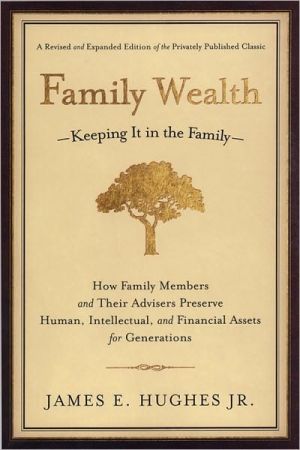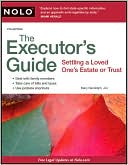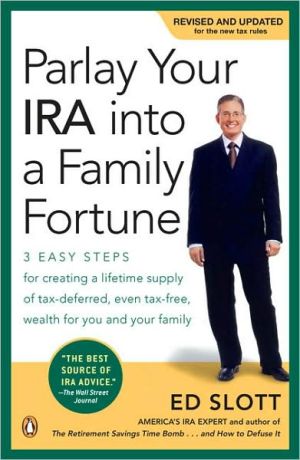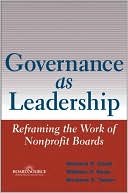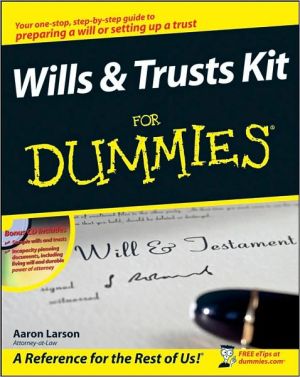Family Wealth: Keeping It in the FamilyHow Family Members and Their Advisers Preserve Human, Intellectual, and Financial Assets for Generations
The landmark book that changed the way exceptional families think about their heritage, their wealth, and their legacy to future generations—now revised and expanded.\ Every family, looking at the next generation, hopes to confer advantages that are more than just material and financial—to inculcate character and leadership, to inspire creativity and enterprise, to help all family members find and follow their individual callings, and to avoid the financial dependency and loss of initiative...
Search in google:
This is the landmark book that changed the way exceptional families think about their heritage, their wealth, and their legacy to future generations - now revised and expanded. "A masterpiece. No one is more astute than Jay Hughes about the topics of family wealth and family life." - Charles W. Collier, Senior Philanthropic Adviser, Harvard Univesity. Soundview Executive Book Summaries How Families Preserve Assets for GenerationsSince 1974, James E. Hughes Jr. has been helping families around the world preserve the wealth they have created over long years of hard work. Seven years ago, he wrote a first edition of Family Wealth: Keeping It in the Family to help families learn how to keep their money long into the future. Since then, this sixth generation counselor-at-law, now retired, has helped many families do this by facilitating family meetings and encouraging them to work through governance issues and write family mission statements. As an expert on estate and trust planning, he has added several chapters to his original publication to address topics including elders, ritual, practices, evaluation of the third generation, mentorship, and the role of the hommes d'affaires. Although the first edition was privately published and sold through word-of-mouth, this newly revised edition is now widely available and even more informative. Rags to Riches to Rags There is a proverb that has many translations across the globe, but in America it usually appears as, "Shirtsleeves to shirtsleeves in three generations." What this saying depicts is the rise and fall of family money: The uneducated first generation starts off toiling its way up from the fields to a fortune while maintaining a frugal lifestyle. The second generation attends university, wears fashionable clothes, owns a mansion in town and an estate in the country, and enters high society. The third generation's many members grow up in luxury, do little or no work, spend the money, and the fourth generation finds itself once again back in the fields performing manual labor. Hughes explains that this rags-to-riches-to-rags cycle is not inevitable. In Family Wealth, he writes, "A family can successfully preserve wealth for more than a hundred years if the system of representative governance it creates and practices is founded on a set of shared values that express that family's differentness.'" To do this, he explains, families must use many quantitative and qualitative techniques to help them over the long haul make more positive than negative decisions about the use of their human, intellectual and financial capital. One of the main points he makes throughout Family Wealth is that, just as in business, a long-term succession plan is the key to a family's success at long-term wealth preservation. Hughes asks, "If the universe can achieve long-term preservation by growing slightly more than is needed to overcome stasis, why shouldn't a family follow the same logic to preserve its wealth?" Control Without Ownership One philosophy that Hughes uses to help families overcome the "shirtsleeves" proverb is the idea of control without ownership. He writes that this means that each family member adopts the idea that "I am the owner of something if I control it, even if I am not the legal owner of that thing." Every plan for long-term wealth preservation, he explains, has to take the issue of control into account and find a way to deal with it positively. To describe how this philosophy works in practice, Hughes relates the story of a wealthy man in his late 60s who wanted to do some estate planning. The client explained that he wanted to leave half of his estate to his wife, and the other half to his children. After Hughes inquired deeper, he found out that the man's wife had no financial education, as well as poor siblings who constantly asked for money. His son was in a rocky second marriage and his daughter was a physician who had successfully warded off two malpractice claims. Learning this, Hughes pointed out that had his client followed his original plan, it was highly unlikely that his family would be financially sound by the time the grandchildren were grown. Family Risks After looking more closely at his own family, Hughes' client realized that, in his wife's case, her relatives would end up with most of her property. In his son's case, his second wife could end up leaving him, putting his assets at risk. And, in his daughter's case, her medical practice left her vulnerable to her patients. Hughes explains that he told his client to teach his family members that controlling something without legally owning it is the best financial position to be in. Hughes explained that if his client's wife were in control of learning how to allocate investments, create a family bank, and manage the family balance sheet, "with strong representatives she has chosen to guide her, and she doesn't bear the risk of ownership while she is learning, then she has a real chance of wealth preservation." The rest of Family Wealth deals with empowering beneficiaries, trustees, peer review, and private trust companies. Why We Like This Book Family Wealth is not just about keeping money in the family. It is also a guidebook that helps families successfully manage their human and intellectual capital. By showing family members how they can make sound financial decisions with love and forethought, Hughes presents practical ways they can benefit others beyond their own lifetime. Copyright © 2005 Soundview Executive Book Summaries
Family Wealth\ keeping it in the family: how family members and their advisers preserve human, intellectual, and financial assets for generations \ \ By James E. Hughes Jr. \ Bloomberg Press\ Copyright © 2004 James E. Hughes Jr.\ All right reserved.\ ISBN: 1-57660-151-X \ \ \ \ Chapter One\ Long-Term Wealth Preservation as a Question of Family Governance \ Family wealth is not self-perpetuating. Without careful planning and stewardship, a hard-earned fortune can easily be dissipated within a generation or two. The phenomenon of the fleeting family fortune is so well-recognized that it inspired a proverb: "Shirtsleeves to shirtsleeves in three generations." Vanishing wealth is not unique to the United States, and variations of this proverb are found around the world, from Asia to Ireland. The Irish variant-"Clogs to clogs in three generations"-depicts things in the following way. The first generation starts out wearing work clogs while digging in a potato field, receives no formal education, and, through very hard work, creates a fortune while maintaining a frugal lifestyle. The second generation attends university, wears fashionable clothes, has a mansion in town and an estate in the country, and eventually enters high society. The third generation's numerous members grow up in luxury, do little or no work, spend the money, and fate the fourth generation to find itself back in the potatofield, doing manual labor. It is a classic three-stage process: first, a period of creativity; second, a period of stasis or maintenance of the status quo; and third, a period of dissipation.\ Is this rags-to-riches-to-rags cycle inevitable? I believe it is not, and in this chapter, I outline my philosophy, describing why most families fail to preserve wealth over a long period of time; explaining why this failure is unnecessary; and proposing a theory and method to practice successful wealth preservation. Below are the question, problem, theory, solution, and practice for how a family can preserve its wealth over a long period of time.\ I. The Question\ Can a family successfully preserve its wealth for more than one hundred years or for at least four generations?\ Allow me to summarize how I came to the discoveries and insights I am sharing with you. In 1967, I started my legal career in the trusts and estates department of Coudert Brothers. My father had then already been at Coudert Brothers for thirty-two years, specializing in corporate law. He continued to practice law at Coudert for another eighteen years. I had the good fortune to practice law with him during all those years and, most importantly, to be his student. His great interest was the succession issues of private and public businesses. He taught me that when businesses fail, it is most often due to poor long-term succession planning.\ One of his favorite lessons came from his experience as a member of several boards of directors. When a new chief executive officer had been elected, my father said, "I would go up and shake the new CEO's hand and offer congratulations. He or she was naturally excited and feeling hugely successful since, in most cases, election as CEO represented the most significant event of the CEO's life and the culmination of years of very hard work. I would then immediately ask, 'Who is your successor?' There would be a look of surprise, and then, in the cases of the great CEOs, deflation, humility, and comprehension took the place of elation on their faces. After all, the most important role in the management of an enterprise is arranging for orderly succession."\ My father's teaching has stayed with me. In every business with which I have been associated, whether public, private, philanthropic, or trust, the issue of succession has been critical to the long-term viability of that business.\ My experience with families is exactly the same. A family's ability to remain in business over a long period of time always comes down to excellent long-term succession planning, regardless of how successful the family is financially.\ Families attempting long-term wealth preservation often don't understand that they are businesses and that the techniques of long-term succession planning practiced by all other businesses are available to them as well. A family that starts its long-term wealth preservation planning by adopting the metaphor that it is a business will begin with a wonderful psychological tool. If a family thinks it is in business to enhance the lives of its individual family members, it discovers the most powerful form of preservation thinking it can do. The business metaphor further brings into a family's planning efforts all of the tools businesses use to be successful. As with all metaphors, one set of ideas created for a specific purpose cannot be perfectly suited to another purpose. The ideas can, however, offer a starting point for learning and for adaptation to the new set of issues being addressed.\ Throughout this book, I will use the following terms.\ Family: Two or more individuals who, either because of bonds of affinity or because of genetic or emotional linkage, think of themselves as related to each other.\ Wealth: The human, intellectual, and financial capital of a family.\ Preserve: A dynamic effort requiring active employment of all elements of a family's human, intellectual, and financial capital in order to maintain the family.\ Long-term: A period of more than one hundred years, or four generations of the family.\ II. The Problem\ The history of long-term wealth preservation in families is a catalog of failures epitomized by the proverb "Shirtsleeves to shirtsleeves in three generations."\ In 1974, I was asked by the sons of an enormously successful businessman in Singapore to come see their father. I was naturally curious about why I, a still very wet-behind-the-ears private-client attorney, was being invited to travel halfway round the world at substantial cost to the family when there must be excellent legal counsel available in Singapore. I suggested that I refer the businessman to someone local, but he was insistent, and so I accepted.\ When the day of the meeting came, I still had no idea why I had been invited. After entering his enormous office and solving, over tea, all of the macroeconomic problems of the world, I was still wondering. Finally this worldly wise, enormously successful man said, "Mr. Hughes, you are probably wondering why I invited you here. We Chinese have a proverb, 'Rice paddy to rice paddy in three generations.' I don't want that to happen to my family. Can you help us using the techniques of families in America to solve this problem?" I was happy to discover that I could help him.\ Through the years since 1974, as I have traveled to meet with families around the world, I have heard the same idea is expressed in varying ways. The shirtsleeves proverb turns out to be culturally universal, capturing a great truth about wealth and human behavior. Unfortunately, it describes only failure.\ The shirtsleeves proverb describes a three-stage process: creation, stasis, and dissipation. Interestingly, this parallels the behavior of energy. As described by the laws of physics, energy comes together to form a new creation, undergoes a period of stasis or balance, and then moves by way of entropy or decay toward disorder. The energy, however, never disappears; it ultimately becomes part of a new creation, and the process begins again. Apparently all forms of life, which can be seen as organized forms of energy, must go through this cycle. The issue for families is whether they can extend the period of creativity through many generations, and thus postpone the periods of stasis and chaos for as long as possible.\ A way I love to teach this lesson is to remind every generation of a family that it is the first generation. It has the same power of creativity as whichever generation was biologically the first. It is only when a family fails to perceive itself as the first generation that it begins to risk resembling the status quo of a second generation or the decay of a third.\ What are some of the reasons this universal cultural proverb remains as true today as in the past?\ First: In all cultures wealth preservation has meant, and continues to mean today, the accumulation of wealth measured as financial capital. Very few families have understood that their wealth consists of three forms of capital: human, intellectual, and financial. Even fewer families have understood that without active stewardship of their human and intellectual capital they cannot preserve their financial capital. In my opinion, the issue most critical to the failure of a family to preserve its wealth is concentration on the family's financial capital to the exclusion of its human and intellectual capital. A family's failure to understand what its wealth is and to manage that wealth successfully dooms that family to fulfill the shirtsleeves proverb. In fact, this concentration on financial capital may even cause it to go out of business in just one generation.\ Second: Families fail to understand that wealth preservation is a dynamic, not a static, process and that each generation of the family must be a first generation-a wealth-creating generation.\ Many family members who have inherited financial wealth have no concept of how difficult it is to create, and often their experience of the wealth creator was negative. These later-generation family members are rarely motivated by the same emotions that fueled the productivity of the originator of the initial family wealth. A family that imagines or, worse, assumes that every member of the family will be a wealth creator, or even that in every generation someone will have the creative instinct to be a great financial wealth creator, is fooling itself. Such a family is in entropy and will swiftly go out of business.\ For a family to preserve wealth, it has to increase its wealth. How can it do this?\ It can give greater thought to the preservation of the family's human and intellectual capital. It can understand its principal role as a dynamic one of creating new human and intellectual capital, while exercising excellence in its stewardship of the financial capital brought into being by the financial wealth creator. It is through such an understanding of each generation's principal role that every generation can, in practice, function as a new first generation of wealth creators.\ Third: Families often fail to apply the appropriate time frames for successful wealth preservation. The result is that planning for the use of the family's human and intellectual capital is far too short-term and individual, and family goals for achievement are set far too low. Time should be measured by the generation. Otherwise, how can a family address whether it will still be in business in the fourth generation? Short-term for a family is twenty years, intermediate-term is fifty years, and long-term is one hundred years. With increasing life expectancy, I'm tempted to lengthen these periods, but for now they offer reasonable measuring sticks.\ Almost every family I encounter is trying desperately to ensure that every year brings an increase to the bottom line of the financial balance sheet. I applaud this as an exercise in good financial stewardship. Unfortunately, though, if looked at over the twenty years of a short-term financial plan, these annual results simply become footnotes. In a fifty-year plan, they do not reach footnote status; they just appear on a bar graph. In a one-hundred-year plan, they are interesting only to the family historians.\ An emphasis on short-term results is usually found cloaked in the mantra, "We are long-term investors." This unrealistic self-assessment frequently masks the fact that the risks necessary to achieve these annual goals-goals that even in a twenty-year cycle are extraordinarily short-term-are far too high in terms of the family's one-hundred-year financial wealth preservation plan. When the twenty-, fifty-, and one-hundred-year terms of measurement are imposed on the family's investment strategy, the discipline of patience, which highlights the success of great investors like Philip Carret and Warren Buffett, shines forth. Patience is a virtue in everything a family does. For families setting their long-term strategies for preserving financial wealth, time is a friend in a way it is not for most investors. Equally, failure to take advantage of time is a waste of a valuable family asset.\ When we move beyond the financial sphere and the family is measuring the preservation of its human and intellectual capital, its failure to understand the proper time frame for measuring success is even more profound. Some years ago, I was discussing the purchase of personal life insurance. I took the opportunity to ask my insurance agent about my life expectancy. I was delighted to hear him confirm that most of us are living longer than our grandparents or parents. He told me that, barring a first heart attack or cancer before the age of fifty-five and assuming we do not smoke, the actuarial expectation for the large majority of us is that we will live well into our eighties and our children will live into their nineties.\ For families in the wealth preservation business, this demographic information is fabulous news. Instead of losing individual family assets in their sixties, the family will get an extra twenty-five years' benefit out of the human and intellectual capital of the majority of its members. Any business that could extend the useful lives of its assets by twenty-five years would be in line for substantially increased profits. Every business knows that the cost of purchase of new assets is high, and keeping existing assets in excellent repair is critical to financial success.\ In families, exactly the same business metaphor applies. When a family measures the useful lives of its members and plans for the maximum use of each member's human and intellectual capital over that member's lifetime, it defies the onset of the energy-depleting stages of status quo and entropy that are the greatest liabilities on its balance sheet. Failure to include the expected contribution and participation of each family member in the twenty-, fifty-, and one-hundred-year plan of a family is to have no plan for the management of the critical human and intellectual components of the family's wealth. Failing to measure properly fails to bring the newest members of the family into the family plan early enough to maximize their lifetime contributions. A business would never squander thirty years of the useful life of an asset. Failure to educate younger family members to a level at which they can participate and contribute to the family balance sheet is as much a waste of family assets as misjudging the useful lives of the oldest members of the family.\ \ Continues...\ \ \ \ Excerpted from Family Wealth by James E. Hughes Jr. Copyright © 2004 by James E. Hughes Jr.. Excerpted by permission.\ All rights reserved. No part of this excerpt may be reproduced or reprinted without permission in writing from the publisher.\ Excerpts are provided by Dial-A-Book Inc. solely for the personal use of visitors to this web site. \ \
1Long-term wealth preservation as a question of family governance32The family mission statement433Ritual514The family balance sheet and family income statement575Investor allocation636Two important practices697The family bank798Protectors, advisers, mentors, and Hommes d'Affaires859Control without ownership9710Beneficiaries10311Trustees11112Family philanthropy12513Evaluating the next generation13314Peer review14115The private trust company14716The role of aunts and uncles15717The art and practice of mentorship16118The role of elders17319The trustee as mentor18120The trustee as regent18921Unexpected consequences of a perpetual trust195
\ Soundview Executive Book SummariesHow Families Preserve Assets for Generations\ Since 1974, James E. Hughes Jr. has been helping families around the world preserve the wealth they have created over long years of hard work. Seven years ago, he wrote a first edition of Family Wealth: Keeping It in the Family to help families learn how to keep their money long into the future. Since then, this sixth generation counselor-at-law, now retired, has helped many families do this by facilitating family meetings and encouraging them to work through governance issues and write family mission statements. As an expert on estate and trust planning, he has added several chapters to his original publication to address topics including elders, ritual, practices, evaluation of the third generation, mentorship, and the role of the hommes d'affaires. Although the first edition was privately published and sold through word-of-mouth, this newly revised edition is now widely available and even more informative. \ Rags to Riches to Rags\ There is a proverb that has many translations across the globe, but in America it usually appears as, "Shirtsleeves to shirtsleeves in three generations." What this saying depicts is the rise and fall of family money: The uneducated first generation starts off toiling its way up from the fields to a fortune while maintaining a frugal lifestyle. The second generation attends university, wears fashionable clothes, owns a mansion in town and an estate in the country, and enters high society. The third generation's many members grow up in luxury, do little or no work, spend the money, and the fourth generation finds itself once again back in the fields performing manual labor.\ Hughes explains that this rags-to-riches-to-rags cycle is not inevitable. In Family Wealth, he writes, "A family can successfully preserve wealth for more than a hundred years if the system of representative governance it creates and practices is founded on a set of shared values that express that family's ‘differentness.'" To do this, he explains, families must use many quantitative and qualitative techniques to help them over the long haul make more positive than negative decisions about the use of their human, intellectual and financial capital.\ One of the main points he makes throughout Family Wealth is that, just as in business, a long-term succession plan is the key to a family's success at long-term wealth preservation. Hughes asks, "If the universe can achieve long-term preservation by growing slightly more than is needed to overcome stasis, why shouldn't a family follow the same logic to preserve its wealth?"\ Control Without Ownership\ One philosophy that Hughes uses to help families overcome the "shirtsleeves" proverb is the idea of control without ownership. He writes that this means that each family member adopts the idea that "I am the owner of something if I control it, even if I am not the legal owner of that thing." Every plan for long-term wealth preservation, he explains, has to take the issue of control into account and find a way to deal with it positively.\ To describe how this philosophy works in practice, Hughes relates the story of a wealthy man in his late 60s who wanted to do some estate planning. The client explained that he wanted to leave half of his estate to his wife, and the other half to his children. After Hughes inquired deeper, he found out that the man's wife had no financial education, as well as poor siblings who constantly asked for money. His son was in a rocky second marriage and his daughter was a physician who had successfully warded off two malpractice claims. Learning this, Hughes pointed out that had his client followed his original plan, it was highly unlikely that his family would be financially sound by the time the grandchildren were grown.\ Family Risks\ After looking more closely at his own family, Hughes' client realized that, in his wife's case, her relatives would end up with most of her property. In his son's case, his second wife could end up leaving him, putting his assets at risk. And, in his daughter's case, her medical practice left her vulnerable to her patients. Hughes explains that he told his client to teach his family members that controlling something without legally owning it is the best financial position to be in. Hughes explained that if his client's wife were in control of learning how to allocate investments, create a family bank, and manage the family balance sheet, "with strong representatives she has chosen to guide her, and she doesn't bear the risk of ownership while she is learning, then she has a real chance of wealth preservation."\ The rest of Family Wealth deals with empowering beneficiaries, trustees, peer review, and private trust companies.\ Why We Like This Book\ Family Wealth is not just about keeping money in the family. It is also a guidebook that helps families successfully manage their human and intellectual capital. By showing family members how they can make sound financial decisions with love and forethought, Hughes presents practical ways they can benefit others beyond their own lifetime. Copyright © 2005 Soundview Executive Book Summaries\ \ \
